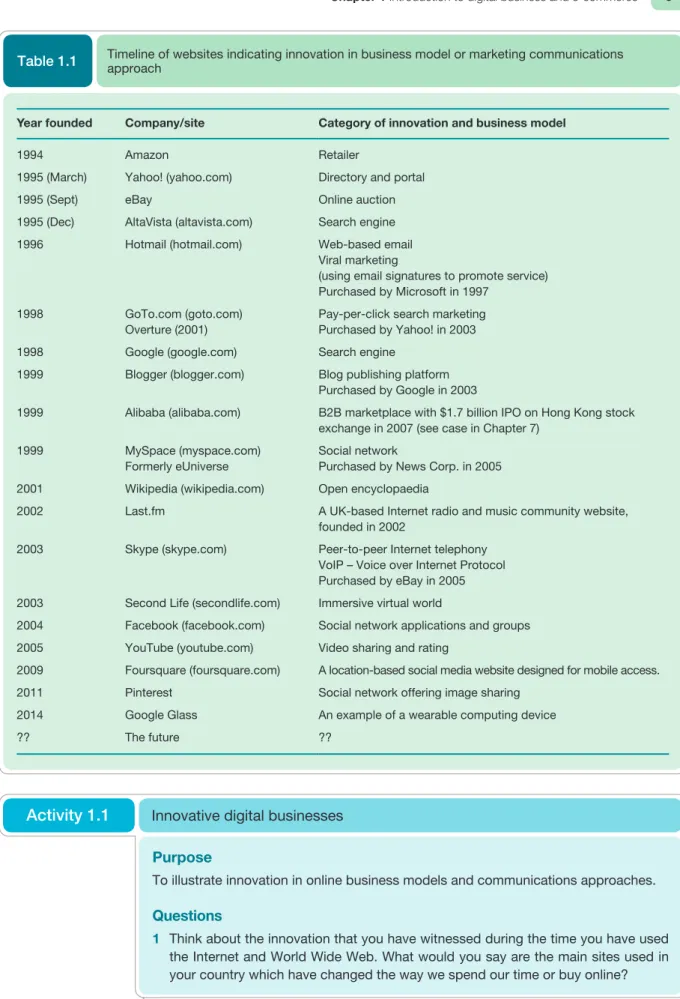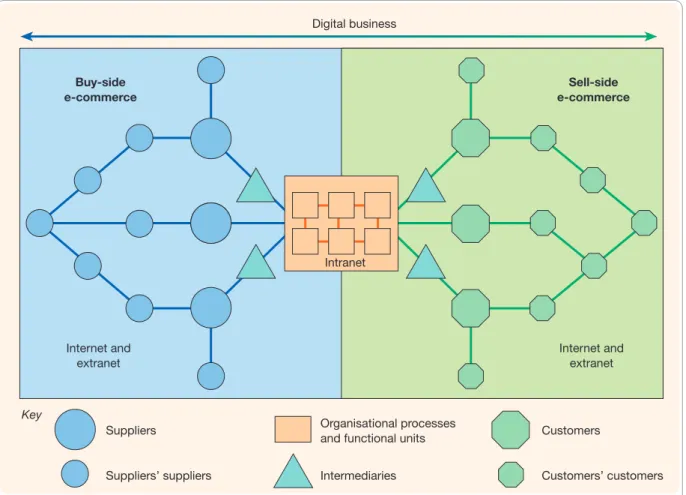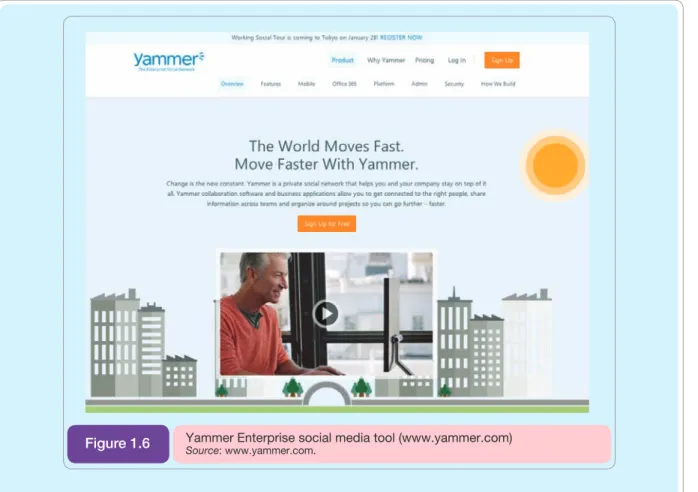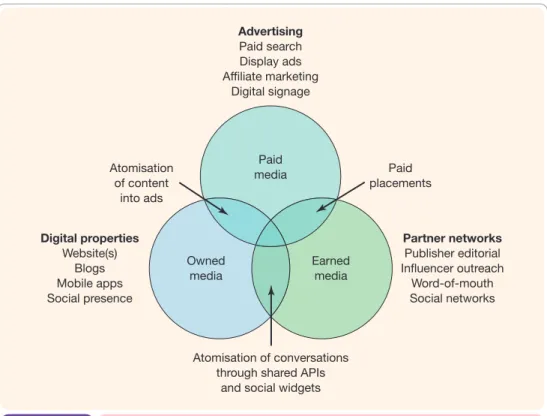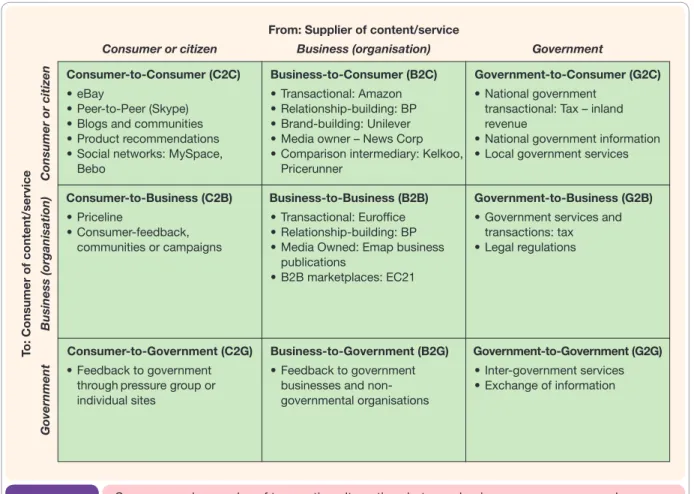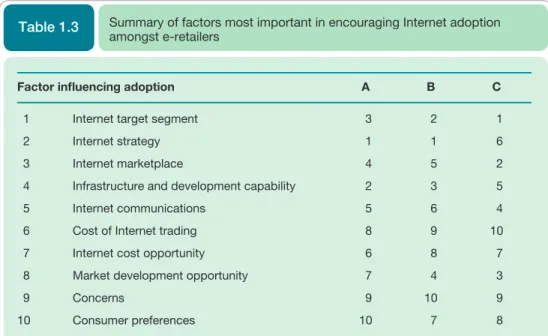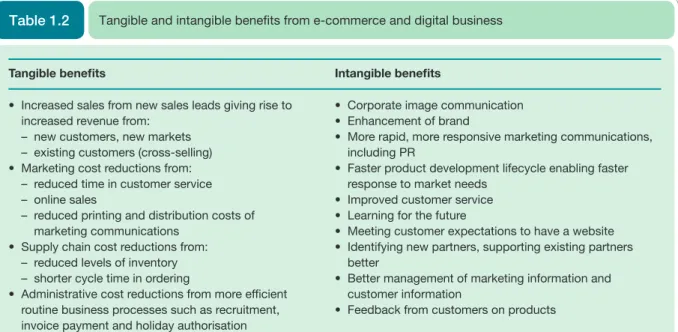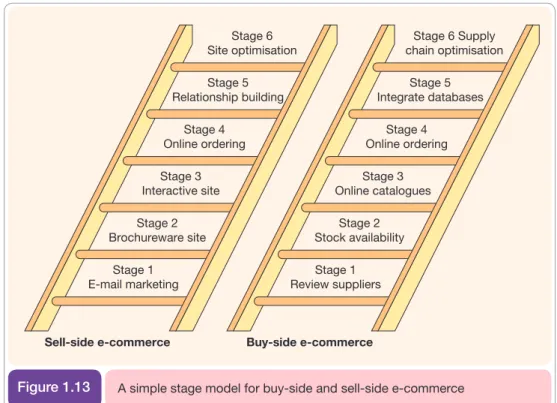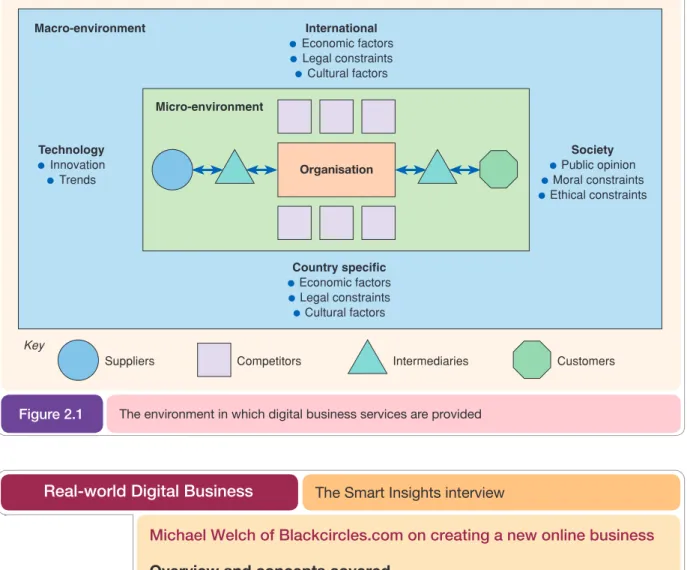Which strategies and actions are needed to develop and sustain a Digital Business?
How should we prioritise our investments in E-commerce and Digital Business?
What are the main changes that need to be made to an organisation to facilitate Digital Business?
The new edition of Dave Chaffey’s bestselling book is your guide to answering these difficult questions. Written in an engaging and informative style, Digital Business and E-Commerce Management will equip you with the knowledge and skills to navigate today’s fast-paced world of continuous technological development.
In this sixth edition of his bestselling book, leading authority Dave Chaffey brings together the most recent academic thinking and professional practice. Covering all aspects of e-business including strategy, digital marketing and supply chain management, Digital Business and E-Commerce Management gives you the benefit of:
•
A structured approach to review, plan and implement e-commerce strategy for all types of organisation•
The latest on digital marketing techniques such as search engine, content and social media marketing•
Expanded coverage of creating integrated experiences for mobile and desktop devices•
Case studies and interviews showing how startups and large organisations have grown through creating effective digital business strategies•
A companion website at www.pearsoned.co.uk/chaffey, providing access to the latest digital business and e-commerce developments via Dave Chaffey’s regularly updated Blog, twitter feed and updates to Dave’s series of books. The website also provides the opportunity for self-assessment and access to extra case studies demonstrating digital business and e-commerce in actionWhether you’re a student studying digital business and e-commerce, or a business manager, Digital Business and E-Commerce Management is the essential text to help you understand and apply digital technology, strategy and implementation.
Dave Chaffey is co-founder of e-commerce advice site SmartInsights.com and a consultant, trainer and visiting lecturer on digital marketing courses at Cranfield School of Management, University of Derby and Manchester Metropolitan University.
www.pearson-books.com
DIGITAL BUSINESS AND E-COMMERCE
MANAGEMENT
DIGITAL BUSINESS AND E-COMMERCE MANAGEMENT
STRATEGY, IMPLEMENTATION AND PRACTICE
STRATEGY, IMPLEMENTATION AND PRACTICE
SIXTH EDITION
SIXTH EDITION
DAVE CHAFFEY
DAVE CHAFFEY
D IG IT A L B U S IN E S S A N D E -C O M M E R C E M A N A GEM E N T
SIXTH EDITION
C H A FFE Y
Digital Business anD e-CommerCe
management
Digital Business anD e-CommerCe
management
Strategy, ImplementatIon and practIce
Dave Chaffey
Harlow CM20 2JE United Kingdom Tel: +44 (0)1279 623623 Web: www.pearson.com/uk First published 2002 (print)
Second edition published 2004 (print) Third edition published 2007 (print) Fourth edition published 2009 (print) Fifth edition published 2011 (print)
Sixth edition published 2015 (print and electronic)
© Dave Chaffey 2002 (Print)
© Marketing Insights Limited 2002, 2009, 2011
© Marketing Insights Limited 2015 (print and electronic)
The right of Dave Chaffey to be identified as author of this work has been asserted by him in accordance with the Copyright, Designs And Patents Act 1988.
The print publication is protected by copyright. Prior to any prohibited reproduction, storage in a retrieval system, distribution or transmission in any form or by any means, electronic, mechanical, recording or otherwise, permission should be obtained from the publisher or, where applicable, a licence permitting restricted copying in the United Kingdom should be obtained from the Copyright Licensing Agency Ltd, Saffron House, 6-10 Kirby Street, London EC1N 8TS.
The ePublication is protected by copyright and must not be copied, reproduced, transferred, distributed, leased, licensed or publicly performed or used in any way except as specifically permitted in writing by the publishers, as allowed under the terms and conditions
under which it was purchased, or as strictly permitted by applicable copyright law. Any unauthorised distribution or use of this text may be a direct infringement of the author’s and the publishers’ rights and those responsible may be liable in law accordingly.
All trademarks used herein are the property of their respective owners. The use of any trademark in this text does not vest in the author or publisher any trademark ownership rights in such trademarks, nor does the use of such trademarks imply any affiliation with or endorsement of this book by such owners.
Pearson Education is not responsible for the content of third-party internet sites.
ISBN: 978-0-273-78654-2 (print) 978-0-273-78657-3 (PDF) 978-0-273-78655-9 (eText)
British Library Cataloguing-in-Publication Data
A catalogue record for the print edition is available from the British Library Library of Congress Cataloging-in-Publication Data
A catalog record for the print edition is available from the Library of Congress 10 9 8 7 6 5 4 3 2 1
18 17 16 15 14
Print edition typeset in 10/12pt MinionPro by 75 Print edition printed and bound by L.E.G.O.S.p.A., Italy
Preface xiv
Guided tour xxvi
About the author xxviii
Publisher’s acknowledgements xxix
Implementation 467
part 3
Strategy and applications 177
part 2
Introduction 1
part 1
1 Introduction to digital business and e-commerce 3
2 Marketplace analysis for e-commerce 41
3 Managing digital business infrastructure 77
4 E-environment 127
5 Digital business strategy 179
6 Supply chain management 247
7 E-procurement 297
8 Digital marketing 323
9 Customer relationship management 387
10 Change management 468
11 Analysis and design 517
12 Digital business service implementation and optimisation 597
Glossary 650
Index 666
Brief contents
Preface xiv
Guided tour xxvi
About the author xxviii
Acknowledgements xxix
Risks and barriers to digital business adoption 32 Evaluating an organisation’s digital
business capabilities 32
Drivers of consumer technology adoption 32 Barriers to consumer Internet adoption 34 Case Study 1.2 eBay – the world’s largest
online business? 34
Summary 37
Exercises 38
References 39
Web links 40
2 Marketplace analysis for e-commerce 41
Learning outcomes 41
Management issues 41
Links to other chapters 41
Introduction 42 Business and revenue models for e-commerce 42
Online marketplace analysis 42
Strategic agility 46
A process for online marketplace analysis 47 Location of trading in the marketplace 53 Review of marketplace channel structures 53 Location of trading in the marketplace 55 The importance of multichannel
marketplace models 55
Commercial arrangement for transactions 57 Different types of online intermediary
and influencers 57
Summary of the types of intermediary 58 The importance of search engines 58 Business models for e-commerce 58
Revenue models 62
Online publisher and intermediary revenue models 62 Calculating revenue for an online business 64
Focus on Online start-up companies 66
Assessing online businesses 67 Valuing Internet start-ups 67
1 Concept 67
2 Innovation 67
3 Execution 67
4 Traffic 68
5 Financing 68
6 Profile 68
Examples of e-commerce failures 68 Case Study 2.1 i-to-i – a global marketplace for a
start-up company 69
Why dot-coms failed 70
part 1
Introduction 1
1 Introduction to digital business and
e-commerce 3
Learning outcomes 3
Management issues 3
Links to other chapters 3
Introduction 4 The impact of electronic communications on
traditional businesses 6
Inbound marketing 6
Social media marketing 7
Trends update: Social media usage 7
Mobile commerce 12
Case Study 1.1 The Facebook business
model 8
Trends update: Mobile usage 12
What is the difference between digital business
and e-commerce? 13
E-commerce defined 13
Trends update: E-commerce growth rates 13
Digital business defined 14
Intranets and extranets 15
Different types of sell-side e-commerce 17
Digital marketing 18
Trends update: Social network usage 19 Options for companies to reach their
audience online 19
Owned, earned and paid media options 19 The six key types of digital media channels 20 Web 2.0 and user-generated content 23
Supply chain management 24
Business or consumer models of e-commerce transactions 24
E-government defined 28
Digital business opportunities 28 Drivers of digital technology adoption 30
Cost/efficiency drivers 30
Competitiveness drivers 30
Contents
Summary 73
Exercises 74
References 75
Web links 76
3 Managing digital business infrastructure 77
Learning outcomes 77
Management issues 77
Links to other chapters 77
Introduction 78 Supporting the growing range of digital business
technology platforms 82
Desktop, laptop and notebook platforms 83 Mobile phone and tablet platforms 83
Trends update: Mobile usage 83
Other hardware platforms 85
Augmented reality 87
Digital business infrastructure components 88 A short introduction to Internet technology 89 Management issues in creating a new
customer-facing digital service 90
Domain name selection 90
Uniform resource locators (URLs) 91
Domain name registration 92
Managing hardware and systems software
infrastructure 92
Layer II – Systems software 93
Managing digital business applications
infrastructure 93 Focus on Web services, SaaS, cloud computing and service-oriented architecture (SOA) 96
Benefits of web services or SaaS 96 Application programming interfaces (APIs) 97 Challenges of deploying SaaS 97
Cloud computing 98
Examples of cloud computing web services 99
Virtualisation 101
Service-oriented architecture (SOA) 102 Selecting hosting providers 102 Managing service quality when selecting Internet service and cloud hosting providers 103
ISP connection methods 103
Issues in management of ISP and hosting
relationships 103
Speed of access 103
Availability 105
Service level agreements 106
Security 106
Managing internal digital communications through
intranets and extranets 107
Intranet applications 107
Extranet applications 109
Encouraging use of intranets and extranets 112
IPTV (Internet TV) 113
Voice over IP (VoIP) 113
Widgets 113
Web presentation and data exchange standards 114
Examples of XML applications 114
Semantic web standards 115
Microformats 116
Focus on Internet governance 116
The net neutrality principle 117
The Internet Corporation for Assigned Names and Numbers (ICANN, www.icann.org) 118 The Internet Society (www.isoc.org) 119 The Internet Engineering Task Force
(IETF, www.ietf.org) 119
The World Wide Web Consortium
(www.w3.org) 119
Telecommunications Information Networking Architecture Consortium (TINA-C,
www.tinac.com/) 119
How can companies influence or take
control of Internet standards? 119
Open-source software 120
Case Study 3.1 Innovation at Google 121
Summary 123
Exercises 123
References 124
Web links 125
4 e-environment 127
Learning outcomes 127
Management issues 127
Links to other chapters 127
Introduction 128
Social and legal factors 131
Factors governing e-commerce service adoption 131 Understanding users’ access requirements 132 Consumers influenced by using the
online channel 133
Motivation for use of online services 133
Purchased online 136
Business demand for digital business services 136
B2B profiles 137
Adoption of digital business by businesses 137 Privacy and trust in e-commerce 138
Privacy legislation 139
Why personal data are valuable for
digital businesses 139
Anti-spam legislation 145
Regulations on privacy and electronic
communications 145
Worldwide regulations on privacy and
electronic communications 145
Other e-commerce legislation 150 1 Marketing your e-commerce business 150 2 Forming an electronic contract (contract law and distance-selling law) 152 3 Making and accepting payment 153 4 Authenticating contracts concluded
over the Internet 153
5 Email risks 153
6 Protecting intellectual property (IP) 153 7 Advertising on the Internet 154
8 Data protection 154
Environmental and green issues related to
Internet usage 154
Taxation 155
Tax jurisdiction 156
Freedom-restrictive legislation 157 Economic and competitive factors 158
Case Study 4.1 The implications of
globalisation for consumer attitudes 160 The implications of e-commerce for international
B2B trading 161
Political factors 162
Internet governance 164
E-government 164 Technological innovation and technology assessment 165 Approaches to identifying emerging technology 168
Summary 170
Exercises 171
References 172
Web links 174
The balanced scorecard approach to
objective setting 216
Strategy definition 217
Selection of digital business strategy
options 217
Decision 1: Digital business channel priorities 218 The diversification of digital platforms 220 Decision 2: Market and product development strategies 220 Decision 3: Positioning and differentiation
strategies 224 Decision 4: Business, service and revenue
models 225 Decision 5: Marketplace restructuring 228 Decision 6: Supply chain management
capabilities 228 Decision 7: Internal knowledge management
capabilities 230 Decision 8: Organisational resourcing and
capabilities 230
Strategy implementation 232
Failed digital business strategies 232 Digital business strategy implementation
success factors for SMEs 234
Case Study 5.3 Boo hoo – learning from
the largest European dot-com failure 234 Focus on Aligning and impacting digital business strategies 237
Elements of IS strategy 238
Investment appraisal 238
Decisions about which business
applications to invest in 240
The productivity paradox 240
Summary 242
Exercises 243
References 244
Web links 246
6 Supply chain management 247
Learning outcomes 247
Management issues 247
Links to other chapters 247
Introduction 248 Problems of supply chain management 251 What is supply chain management? 252
Using technology to support supply chain
management – an example 253
A simple model of a supply chain 255 Case Study 6.1 Shell Chemicals redefines its
customers’ supply chains 259
What is logistics? 263
Push and pull supply chain models 265
Focus on The value chain 266
Restructuring the internal value chain 267
The value stream 268
Value chain analysis 268
Value networks 270
Towards the virtual organisation 271 Options for restructuring the supply chain 272
part 2
Strategy and applications 177 5 Digital business strategy 179
Learning outcomes 179
Management issues 179
Links to other chapters 179
Introduction 180 Development of the social business 180 What is digital business strategy? 184 The imperative for digital business strategy 185 Digital channel strategies 186 Strategy process models for digital business 189
Strategic analysis 192
Resource and process analysis 193 Stage models of digital business development 193 Application portfolio analysis 195 Organisational and IS SWOT analysis 196 Human and financial resources 197 Competitive environment analysis 198
Demand analysis 199
Assessing competitive threats 199
Competitive threats 199
Sell-side threats 201
Buy-side threats 202
Co-opetition 203
Competitor analysis 203
Resource-advantage mapping 203
Strategic objectives 203
Defining vision and mission 203 How can digital business create business value? 207 Case Study 5.1 Debenhams creates value through
mobile commerce 208
Objective setting 209
The online revenue contribution 211 Conversion modelling for sell-side
e-commerce 211
Case Study 5.2 Setting the Internet revenue
contribution at Sandvik Steel 213
Using digital business to restructure the
supply chain 275
Technology options and standards for supply
chain management 275
Adoption rates of digital business applications 277 Benefits of e-supply chain management 277 Case Study 6.2 Argos uses e-supply chain
management to improve customer convenience 278 IS-supported upstream supply chain
management 280
RFID and The Internet of Things 280 IS-supported downstream supply chain
management 281 Outbound logistics management 281 IS infrastructure for supply chain management 283 Supply chain management implementation 284 Data standardisation and exchange 284 The supply chain management strategy
process 285 Goal-setting and performance management
for e-SCM 287
Managing partnerships 287
Managing global distribution 289 Case Study 6.3 RFID: keeping track starts
its move to a faster track 290
Summary 292
Exercises 292
References 293
Web links 295
7 e-procurement 297
Learning outcomes 297
Management issues 297
Links to other chapters 297
Introduction 298
What is e-procurement? 299
Understanding the procurement process 301
Types of procurement 302
Participants in different types of
e-procurement 303
Drivers of e-procurement 304
Examples of the benefits of e-procurement 305 Case Study 7.1 Cambridge Consultants reduces costs through e-procurement 306 Focus on Estimating e-procurement costs 308 The impact of cost savings on profitability 308 Barriers and risks of e-procurement adoption 310
Implementing e-procurement 310
Integrating company systems with
supplier systems 312
Focus on B2B marketplaces 314
Why did so many B2B marketplaces fail? 316 Reasons for limited adoption of
e-marketplaces 316
From neutral to private B2B exchanges 316 Case Study 7.2 Covisint – a typical history of a
B2B marketplace? 317
Types of marketplace 318
The future of e-procurement 319
Summary 320
Exercises 320
References 321
Web links 322
8 Digital marketing 323
Learning outcomes 323
Management issues 323
Links to other chapters 323
Introduction 324
Chapter structure 325
What is digital marketing? 328
Marketing defined 328
Digital marketing defined 330
Inbound marketing 331
Content marketing 331
Digital marketing planning 334
Is a separate digital marketing plan
required? 335
Situation analysis 336
Customer demand analysis 338
Qualitative customer research 340
Competitor analysis 341
Intermediary or influencer analysis 343
Internal marketing audit 344
Objective setting 344
Case Study 8.1 The evolution of easyJet’s online
revenue contribution 347
Strategy 350 Market and product positioning 351
Target market strategies 352
Content strategy 357
Focus on Characteristics of digital media
communications 358
1 Interactivity 358
2 Intelligence 359
3 Individualisation 360
4 Integration 361
5 Industry restructuring 363
6 Independence of location 363
Tactics 363 Product 366 Case Study 8.2 Dell gets closer to its
customers online 368
Price 371 Place 374 Promotion 376 People, process and physical evidence 377
Focus on Online branding 378
Brand identity 379
The importance of brand online 380 Actions 381 Control 383
Summary 383
Exercises 383
References 384
Web links 386
9 Customer relationship management 387 Learning outcomes 387 Management issues 387 Links to other chapters 387 Introduction 388 Marketing applications of CRM 389
What is e-CRM? 393
From e-CRM to social CRM 393
Benefits of e-CRM 394
Customer engagement strategy 395
Permission marketing 395
Customer profiling 396
Conversion marketing 397
The online buying process 400
Differences in buyer behaviour in target markets 400 Differences between B2C and B2B
buyer behaviour 401
Influences on purchase 401
The net promoter score 402
Customer acquisition management 404 Focus on Marketing communications for customer acquisition, including search engine marketing, online PR, online partnerships, interactive advertising, email marketing
and social media marketing 405
The characteristics of interactive marketing
communications 405
1 From push to pull 405
2 From monologue to dialogue 405
3 From one-to-many to one-to-some and
one-to-one 405
4 From one-to-many to many-to-many
communications 406
5 From ‘lean-back’ to ‘lean-forward’ 406 6 The medium changes the nature of standard marketing communications tools such
as advertising 406
7 Increase in communications intermediaries 406 8 Integration remains important 407 Assessing marketing communications
effectiveness 407 Online marketing communications 409 1 Search engine marketing (SEM) 409
2 Online PR 416
Focus on Social media and social CRM strategy 418
3 Online partnerships 426
4 Interactive advertising 428
5 Email marketing 431
Social media marketing 435
Customer retention management 436 Personalisation and mass customisation 438
Creating personalisation 439
Extranets 439
Opt-in email 440
Techniques for managing customer activity
and value 440
Lifetime-value modelling 442
Focus on Excelling in e-commerce service quality 443 Improving online service quality 445
Tangibles 445
Reliability 445
Responsiveness 445
Assurance 446
Empathy 446
Customer extension 448
Advanced online segmentation and targeting techniques 448
Sense, Respond, Adjust – delivering relevant e-communications through monitoring
customer behaviour 450
Recency, Frequency, Monetary value (RFM)
analysis 451
Technology solutions for CRM 454 Types of CRM applications 455 Integration with back-office systems 456 The choice of single-vendor solutions or a more
fragmented choice 456
Data quality 457
Case Study 9.1 Tesco.com increases product range and uses triggered communications to
support CRM 457
Summary 459
Exercises 460
References 461
Further reading 464
Web links 465
part 3
Implementation 467
10 Change management 468
Learning outcomes 468
Management issues 468
Links to other chapters 468
Introduction 469 The challenges of digital business transformation 472
The challenges of sell-side e-commerce
implementation 473 Different types of change in business 478
Business process management 479
Discontinuous process change 479
Case study 10.1 Process management: making
complex business simpler 481
Planning change 483
The imperative for project governance? 483 The project plan and schedule for a digital
business system 487
Prototyping 489
Agile software development 490
Human resource requirements 490
Staff retention 492
Outsourcing 492 Revising organisational structures 494 Approaches to managing change 496 Senior management involvement 497 Models for achieving change 498
Organisational culture 500
Focus on Knowledge management 501
What is knowledge? 502 Objectives of knowledge management 503 Implementing knowledge management 504 Technologies for implementing knowledge
management 505 Using collaborative approaches for knowledge management 507 Case Study 10.2 Using collaborative tools
to support knowledge management at
Janssen-Cilag Australia 507
Towards the social business 510
What is social business? 510
Risk management 511
Summary 512
Exercises 513
References 514
Web links 516
11 analysis and design 517
Learning outcomes 517
Management issues 517
Links to other chapters 517
Introduction 518 Analysis for digital technology projects 521
Process modelling 522
Process mapping 522
Task analysis and task decomposition 523
Process dependencies 524
Workflow management 524
Flow process charts 525
Effort duration analysis 526
Network diagrams 528
Event-driven process chain (EPC) model 529 Validating a new process model 531
Data modelling 531
1 Identify entities 531
2 Identify attributes for entities 531 3 Identify relationships between entities 531
Big Data and data warehouses 533
Design for digital technology projects 536 Architectural design of digital business systems 536 Focus on User-centred site design and customer
experience management 538
Usability 543
Evaluating designs 544
Use-case analysis 544
Persona and scenario analysis 545
Stages in use-case analysis 547
Designing the information architecture 550
Card sorting 552
Blueprints 552
Wireframes 552
Customer orientation 555
Elements of site design 558
Site design and structure 558
Page design 562
Content design 562
Mobile design 562
Mobile site design option A. Simple mobile site 563
Mobile site design option B. Screen-scrape 564 Mobile site design option C. Responsive
design 564
Mobile site design option D. HTML5 565 Mobile site design option E. Adaptive
design 567
Web accessibility 567
Case Study 11.1 Providing an effective online experience for local markets 570 Focus on Security design for digital business 572 Managing computer viruses 577
Types of virus 577
Protecting computer systems against viruses 578 Controlling information service usage 579 Monitoring of electronic communications 579 Employee monitoring legislation 582
Email management 583
1 Minimising spam (unsolicited email) 583 2 Minimising internal business email 585 3 Minimising external business email 586 4 Minimising personal email (friends and family) 586 Hacking 586 Protecting computer systems against hackers 587 Secure e-commerce transactions 588
Principles of secure systems 588
Approaches to developing secure systems 589
Digital certificates 589
Digital signatures 590
The public-key infrastructure (PKI) and
certificate authorities (CAs) 590
Virtual private networks 590
Current approaches to e-commerce security 590 Secure Sockets Layer Protocol (SSL) 590 Certificate authorities (CAs) 591
Reassuring the customer 591
Summary 592
Exercises 592
References 593
Web links 595
12 Digital business service implementation
and optimisation 597
Learning outcomes 597
Management issues 597
Links to other chapters 597
Introduction 598 Optimisation of digital business services 599 Alternatives for acquiring digital business systems 602
Managing web content 603
Web application frameworks and application
servers 605
Content management systems 606
Selecting e-commerce servers 607
Testing 608
The testing process 608
Testing environments 609
Changeover 609 Database creation and data migration 610
Deployment planning 611
Content management and maintenance 611 Managing a content marketing strategy 611 Frequency and scope of content and site
updating 614
Maintenance process and responsibilities 615 Process for routine content changes 615 Frequency of content updates 618 Process for major changes 618 Initiatives to keep content fresh 618 Managing content for a global site 620 Focus on Web analytics: measuring and improving performance of digital business services 621
Principles of performance management and
improvement 621
Stage 1: Creating a performance management
system 622
Stage 2: Defining the performance metrics
framework 623
1 Channel promotion 624 2 Channel buyer behaviour 625 3 Channel satisfaction 625 4 Channel outcomes 626
5 Channel profitability 627 Multichannel evaluation 627 Focus on Measuring social media marketing 628
Stage 3: Tools and techniques for collecting
metrics and summarising results 629 Collecting site-visitor activity data 629 Comparing apples to oranges? 630 Collecting site outcome data 631 Selecting a web analytics tool 632 AB and multivariate testing 635 Clickstream analysis and visitor
segmentation 637
Budgeting 639
Case Study 12.1 Learning from Amazon’s
culture of metrics 642
Summary 647
Exercises 647
References 648
Web links 649
Glossary 650
Index 666
Lecturer Resources
For password-protected online resources tailored to support the use of this textbook in teaching, please visit www.pearsoned.co.uk/chaff ey
ON THE WEBSITE
In 1849, a group of settlers travelling west towards the promised land, California, entered a then unnamed valley. The valley presented a harsh environment with a barrier of moun- tains to the west making the way forward unclear. Some of the settlers lost their lives as they sought to find a route west before eventually reaching California and what was to become one of the most prosperous places on earth. As the group left the valley, one of the women in the group turned and said, ‘Goodbye, Death Valley’, and hence the valley got its name.
Today, flagship digital businesses with headquarters in California, such as eBay, Facebook and Google, are now leading global brands with turnovers of billions of dollars, yet this has happened in a few short years, less than 300 years after the first modern settlers arrived.
Likewise for other businesses, the road to digital business success is not straightforward and fraught with difficulties of selecting the correct strategic direction and surviving in an increasingly harsh competitive environment. Not all who follow the route survive. But whether it’s the start-up businesses or an existing business, what they have in common is that those who prosper learn to optimise to take the right strategic decisions about digital technology, digital marketing and supply chain management.
This book is intended to equip current and future managers with some of the knowledge and practical skills to help them navigate their organisation towards digital business.
A key aim of this book is to identify and review the key management decisions required by organisations moving to digital business and consider the process by which these deci- sions can be taken. Key questions include: What approach to digital business strategy do we follow? How much do we need to invest in digital business? Which processes should be our digital business priorities? Should we adopt new business and revenue models? What are the main changes that need to be made to the organisation to facilitate digital business?
Given the broad scope of digital business, this book takes an integrative approach drawing on new and existing approaches and models from many disciplines, including information systems, strategy, marketing, supply chain management, operations and human resources management.
What is digital business management?
As we will see in Chapter 1, digital business is aimed at enhancing the competitiveness of an organisation by deploying innovative digital technologies throughout an organisation and beyond, through links to partners and customers and promotion through digital media.
It does not simply involve using technology to automate existing processes, but is about digital transformation by applying technology to help change these processes to add value to the business and its customers. To be successful in managing digital business, a breadth of knowledge is needed of different business processes and activities from across the value chain, such as marketing and sales, through new product development, manufacturing and
Digital business how businesses apply digital technology and media to improve the competitiveness of their organisation through optimising internal processes with online and traditional channels to market and supply.
Preface
inbound and outbound logistics. Organisations also need to manage the change required by new processes and technology through what have traditionally been support activities such as human resources management.
From this definition, it is apparent that digital business involves looking at how electronic communications can be used to enhance all aspects of an organisation’s supply chain man- agement. it also involves optimising an organisation’s value chain, a related concept that describes the different value-adding activities that connect a company’s supply side with its demand side. the digital business era also involves management of a network of interrelated value chains or value networks.
value chain A model for analysis of how supply chain activities can add value to products and services delivered to the customer.
value networks The links between an organisation and its strategic and non- strategic partners that form its external value chain.
electronic commerce (e-commerce) All electronically mediated information exchanges between an organisation and its external stakeholders.
Buy-side e-commerce E-commerce transactions between an organisation and its suppliers and other partners.
Sell-side e-commerce E-commerce transactions between an organisation and its customers.
Social media A category of media focussing on participation and peer-to-peer communication between individuals, with sites providing the capability to develop user-generated content (ugc) and to exchange messages and comments between different users.
What is e-commerce management?
Supply chain management (scm) The coordination of all supply activities of an organisation from its suppliers and partners to its customers.
To set the scope of this book, in its title we reference both ‘digital business’ and ‘e-commerce’.
Both these terms are applied in a variety of ways; to some they mean the same, to others they are quite different. As explained in Chapter 1, what is most important is that they are applied consistently within organisations so that employees and external stakeholders are clear about how the organisation can exploit electronic communications. The distinction made in this book is to use electronic commerce (e-commerce) to refer to all types of elec- tronic transactions between organisations and stakeholders, whether they are financial trans- actions or exchanges of information or other services. These e-commerce transactions are either buy-side e-commerce or sell-side e-commerce and the management issues involved with each aspect are considered separately in Part 2 of the book. ‘Digital business’ is applied as a broader term encompassing e-commerce but also including all electronic transactions within an organisation.
Management of e-commerce involves prioritising buy-side and sell-side activities and putting in place the plans and resources to deliver the identified benefits. These plans need to focus on management of the many risks to success, some of which you may have experi- enced when using e-commerce sites, from technical problems such as transactions that fail, sites that are difficult to use or are too slow, through to problems with customer service or fulfilment, which also indicate failure of management. Today, the social media or peer-to- peer interactions that occur between customers on company websites, blogs, communities and social networks have changed the dynamics of online commerce. Likewise, the frenzied consumer adoption of mobile technology platforms via mobile sites and mobile apps offers new platforms to interact with customers which must be evaluated and prioritised. Deciding which of the many emerging technologies and marketing approaches to prioritise and which to ignore is a challenge for all organisations!
how is this book structured?
The overall structure of the book, shown in Figure P.1, follows a logical sequence: introduc- ing the foundations of digital business concepts in Part 1; reviewing alternative strategic approaches and applications of digital business in Part 2; and how strategy can be imple- mented in Part 3. Within this overall structure, differences in how electronic communi- cations are used to support different business processes are considered separately. This is achieved by distinguishing between how electronic communications are used, from buy-side e-commerce aspects of supply chain management in Chapters 6 and 7, to the marketing perspective of sell-side e-commerce in Chapters 8 and 9. Figure P.1 shows the emphasis of perspective for the particular chapters.
Part 1: Introduction (Chapters 1–4)
Part 1 introduces digital business and e-commerce. It seeks to clarify basic terms and concepts by looking at different interpretations of terms and applications through case studies.
● Chapter 1: Introduction to digital business and e-commerce. Definition of the meaning and scope of digital business and e-commerce. Social media, social commerce and mobile apps are also introduced. Introduction to business use of the internet – what are the bene- fits and barriers to adoption and how widely used is it?
● Chapter 2: Marketplace analysis for e-commerce. Introduction to new business models and marketplace structures enabled by electronic communications.
● Chapter 3: Managing digital business infrastructure. Background on the hardware, software and telecommunications that need to be managed to achieve digital business.
● Chapter 4: E-environment. Describes the macro-environment of an organisation, which presents opportunities and constraints on strategy and implementation.
Part 2: Strategy and applications (Chapters 5–9)
In Part 2 of the book, approaches to developing digital business strategy and applications are reviewed for the organisation as a whole (Chapter 5) and with an emphasis on buy-side e-commerce (Chapters 6 and 7) and sell-side e-commerce (Chapters 8 and 9).
● Chapter 5: Digital business strategy. Approaches to developing digital business strategy.
Differences from traditional strategic approaches. Relation to IS strategy.
● Chapter 6: Supply chain management. A supply chain perspective on strategy with examples of how technology can be applied to increase supply chain and value chain efficiency.
● Chapter 7: E-procurement. Evaluation of the benefits and practical issues of adopting e-procurement.
● Chapter 8: Digital marketing. A sell-side e-commerce perspective to digital business, reviewing differences in marketing required through digital media. Structured around developing a digital marketing plan.
● Chapter 9: Customer relationship management. Reviews marketing techniques that apply e-commerce for acquiring and retaining customers.
Part 3: Implementation (Chapters 10–12)
Management of digital business implementation is described in Part 3 of the book in which we examine practical management issues involved with creating and maintaining digital business solutions.
● Chapter 10: Change management. How to manage the organisational, human and tech- nology changes required in the move to digital business.
● Chapter 11: Analysis and design. We discuss the main issues of analysis and design raised by e-commerce systems that need to be discussed by managers and solutions providers.
● Chapter 12: Digital business implementation and optimisation. How should e- commerce systems be managed and monitored once they are live?
Mobile technology platforms
Devices and services used by consumers to interact with other consumers and companies including smartphones, tablets and wearable technology.
Mobile apps A software application that is designed for use on a mobile phone or tablet, typically downloaded from an app store. Iphone apps are best known, but all smart phones support the use of apps which can provide users with information, entertainment or location- based services such as mapping.
Figure p.1 Structure of the book
Part 1 INTRODUCTION
Sell-side e-commerce emphasis Digital business emphasis Key
Chapter 1 Introduction to digital business and e-commerce
Chapter 2 Marketplace analysis for e-commerce
Chapter 3 Managing digital business infrastructure
Chapter 4 E-environment
Part 2 STRATEGY AND APPLICATIONS
Chapter 5 Digital business strategy
Chapter 6 Supply chain management
Chapter 7 E-procurement
Chapter 8 Digital marketing
Chapter 9 Customer relationship management
Part 3 IMPLEMENTATION
Chapter 10 Change management
Chapter 11 Analysis and design
Chapter 12 Digital business service implementation and optimisation
Who should use this book?
Students
This book has been created as the main student text for undergraduate and postgraduate stu- dents taking specialist courses or modules which cover digital business, e-commerce infor- mation systems or digital marketing. The book is relevant to students who are:
● undergraduates on business programmes which include modules on the use of the Internet and e-commerce; this includes specialist degrees such as electronic business, electronic commerce, internet marketing and marketing or general business degrees such as busi- ness studies, business administration and business management;
● undergraduate project students who select this topic for final-year projects or dissertations – this book is an excellent resource for these students;
● undergraduates completing work placement involved with different aspects of digital busi- ness such as managing an intranet or company website;
● postgraduate students on specialist masters degrees in electronic commerce, electronic business or digital marketing and generic MBA, Certificate in Management or Diploma in Management Studies which involve modules or electives for electronic commerce and digital marketing.
What does the book offer to lecturers teaching these courses?
The book is intended to be a comprehensive guide to all aspects of deploying digital business and e-commerce within an organisation. The book builds on existing theories and concepts and questions the validity of these models in the light of the differences between the inter- net and other media. The book references the emerging body of literature specific to digital business, e-commerce and digital marketing. As such, it can be used across several modules.
Lecturers will find that the book has a good range of case studies, activities and exercises to support their teaching. These activities assist in using the book for student-centred learning as part of directed study. Web links given in the text and at the end of each chapter highlight key information sources for particular topics.
Practitioners
There is also much of relevance in this book for the industry professional, including:
● senior managers and directors seeking to apply the right digital business and e-commerce approaches to benefit their organisation;
● information systems managers who are developing and implementing digital business and e-commerce strategies;
● marketing managers responsible for defining a digital marketing strategy and implement- ing and maintaining the company website;
● supply chain, logistics and procurement managers wanting to see examples of best practice in using e-commerce for supply chain management;
● technical project managers or webmasters who may understand the technical details of building a site, but have a limited knowledge of business or marketing fundamentals.
Student learning features
A range of features have been incorporated into this book to help the reader get the most out of it. They have been designed to assist understanding, reinforce learning and help readers find information easily. The features are described in the order you will encounter them.
at the start of each chapter
● Chapter at a glance: a list of main topics, ‘focus on’ topics and case studies.
● Learning outcomes: a list describing what readers can learn through reading the chapter and completing the activities.
● Management issues: a summary of main issues or decisions faced by managers related to the chapter topic area.
● Web support: additional material on the companion website.
● Links to other chapters: a summary of related topics in other chapters.
● Introductions: succinct summaries of the relevance of the topic to marketing students and practitioners together with content and structure.
In each chapter
● Activities: short activities in the main text that develop concepts and understanding, often by relating to student experience or through reference to websites. Model answers to activities are provided at the end of the chapter where applicable.
● Case studies: real-world examples of issues facing companies that implement digital busi- ness. Questions at the end of the case study highlight the main learning points from that case study.
● Real-world digital business experiences: interviews with e-commerce managers at a range of UK, European and US-based organisations concerning the strategies they have adopted and their approaches to strategy implementation.
● Digital trends updates. References to relevant statistical sources to update information on the latest consumer and business adoption of digital technology.
● Box features: these explore a concept in more detail or give an example of a principle dis- cussed in the text.
● ‘Focus on’ sections: more detailed coverage of specific topics of interest.
● Questions for debate: suggestions for discussion of significant issues for managers involved with the transformation required for digital business.
● Definitions: when significant terms are first introduced the main text contains succinct definitions in the margin for easy reference.
● Web links: where appropriate, web addresses are given for further information, particu- larly those that update information.
● Chapter summaries: intended as revision aids and to summarise the main learning points from the chapter.
at the end of each chapter
● Self-assessment exercises: short questions which will test understanding of terms and con- cepts described in the chapter.
● Discussion questions: require longer essay-style answers discussing themes from the chap- ter, and can be used for essays or as debate questions in seminars.
●
